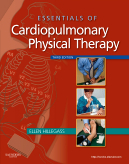Category:Cardiopulmonary: Difference between revisions
No edit summary |
No edit summary |
||
| Line 11: | Line 11: | ||
|- | |- | ||
| align="center" | <imagemap> | | align="center" | <imagemap> | ||
Image:Hillegass-book. | Image:Hillegass-book.jpg|150px|border|left| | ||
default [http://bit.ly/1j2YFy5] | default [http://bit.ly/1j2YFy5] | ||
desc none | desc none | ||
</imagemap> | </imagemap> | ||
| | | | ||
[http://bit.ly/1j2YFy5 Essentials of Cardiopulmonary Physical Therapy] provides | [http://bit.ly/1j2YFy5 Essentials of Cardiopulmonary Physical Therapy] provides comprehensive coverage of anatomy and physiology, assessment, and aspects of the cardiopulmonary systems, with a focus on their interaction. The disablement model is used in describing the eight cardiopulmonary practice patterns. Expert author Ellen Hillegass also discusses pathophysiology, pharmacology, and interventions in the outpatient setting. Incorporating Guide language, her practical approach progresses logically from basic sciences through intervention, and emphasizes lifespan considerations. | ||
[# Sample chapter: | [# Sample chapter: Coming soon] | ||
[http://bit.ly/1j2YFy5 Buy with 20% discount by clicking here!!] | [http://bit.ly/1j2YFy5 Buy with 20% discount by clicking here!!] | ||
Revision as of 16:46, 7 May 2014
Cardiopulmonary physiotherapists work with patients in a variety of settings. They treat acute problems like asthma, acute chest infections and trauma; they are involved in the preparation and recovery of patients from major surgery; they also treat a wide range of chronic cardiac and respiratory conditions like Chronic Obstructive Pulmonary Disease (COPD), cystic fibrosis (CF) and post-myocardial infarction (MI). They work with all ages from premature babies to older adults at the end of their life.
Physiotherapists are pioneering new management techniques for non-organic respiratory problems like hyperventilation and other stress-related disorders as well as leading the development of cardio-pulmonary rehabilitation and non-invasive ventilation. Cardiopulmonary physiotherapists use physical modalities to treat people. This may involve using manual techniques to clear infected mucus from a person's chest, or using non-invasive ventilation to help a person breathe, or prescribing exercises to improve a patient's functional exercise capacity.
Recent Related Research (from Physiospot)[edit | edit source]
Related books from Elsevier[edit | edit source]
|
Essentials of Cardiopulmonary Physical Therapy provides comprehensive coverage of anatomy and physiology, assessment, and aspects of the cardiopulmonary systems, with a focus on their interaction. The disablement model is used in describing the eight cardiopulmonary practice patterns. Expert author Ellen Hillegass also discusses pathophysiology, pharmacology, and interventions in the outpatient setting. Incorporating Guide language, her practical approach progresses logically from basic sciences through intervention, and emphasizes lifespan considerations. [# Sample chapter: Coming soon] |
Subcategories
This category has the following 14 subcategories, out of 14 total.
A
C
- Cardiopulmonary - Anatomy (8 P)
- Cardiopulmonary - Conditions (20 P)
- Cardiopulmonary - Guidelines (4 P)
- Cardiopulmonary - Interventions (25 P)
- Cystic Fibrosis - Case Studies (empty)
P
Pages in category "Cardiopulmonary"
The following 164 pages are in this category, out of 164 total.
A
- Abdominal Aortic Aneurysm
- Acapella
- Acclimatisation
- Active Cycle of Breathing Technique
- Acute Coronary Syndrome
- Acute Respiratory Distress Syndrome (ARDS)
- Allergic Bronchopulmonary Aspergillosis
- Anatomy of the Human Heart
- Arterial Blood Gases
- Assessment of Breathing Pattern Disorders
- Assisted Coughing
- Asthma
- Atelectasis
- Atrial Fibrillation
- Auscultation
- Autogenic Drainage
B
C
- Capnography
- Cardiac Depression Scale
- Cardiac Rehabilitation
- Cardiopulmonary Exercise Testing (CPET) In Adults
- Cardiovascular Considerations in the Older Patient
- Cardiovascular Disease
- Cardiovascular Exercises For Elderly
- Case Study using ICF : COPD
- Case Study using ICF : Interstitial Lung Disease
- Chest Drains
- Chest X-Rays
- Chronic Bronchitis
- Chronic Obstructive Pulmonary Disease Rehabilitation Class
- Clinical Guidelines: Cardiopulmonary
- Common Carotid Artery
- Computerized Adventitious Respiratory Sounds Analysis
- Congestive Heart Failure
- Congestive Heart Failure - Pharmacotherapy
- COPD (Chronic Obstructive Pulmonary Disease)
- Cornet
- Coronary Artery
- Coronary Artery Bypass Graft
- Creatine and Exercise
- Critical Care Assessment
- Critical Illness Polyneuropathy (CIP)
- Cyanosis
- Cystic Fibrosis
H
I
L
M
N
P
- Pancoast Tumor
- Paraneoplastic Syndrome
- Patient Guide: Cardiopulmonary
- Patient Recommendations for Congestive Heart Failure
- Pectus Carinatum (pigeon chest )
- Percussion
- Peripheral Arterial Disease
- Perme Intensive Care Unit Mobility Score
- Pharmacological Management of Hypertension
- Phrenic Nerve
- Physical Activity and Cardiovascular Disease
- Physical Activity and Respiratory Conditions
- Physiotherapists Role in ICU
- Physiotherapy and Pilates to Improve Pulmonary Function
- Physiotherapy in Palliative Care
- Pleural Effusion
- Pleural Friction Rub
- Pneumonia
- Pneumorrhachis
- Pneumothorax
- Polyarteritis Nodosa
- Positive Expiratory Pressure (PEP) Devices
- Post-Operative Pulmonary Complication
- Postural Drainage
- Postural Tachycardia Syndrome (POTS)
- Pulmonary Embolism
- Pulmonary Fibrosis
- Pulmonary Function Test
- Pulmonary Rehabilitation







